These musings were first posted as messages on the on the former Yahoo Groups flphg list, which has been closed.
Those thoughts have been refined since and put into a document:
FLPHGHandling.pdf (550 KB). A summary of this document follows.
A brief summary: I make the
case that thrust line is a significant part of the handling under
power, and that many things a hang glider pilot is taught, like leading
a turn with their feet, are counter-productive when flying with
power. I recommend reading the above pdf file for the complete
story. What follows here is a very condensed version consisting
mainly of the figures with a small amount of explanation. If
something in the figures is not clear, I recommend reading the full
version above.
Note: Some very good references
for how hang gliders fly and factors affecting their handling, see the
series of books by
Dennis
Pagen (
http://pagenbooks.com/).
Assumptions and Conventions
In the following I will use the convention that all forces are those
acting on
the glider. While it is pretty obvious that the Lift force acts upward,
there has
been some
confusion about the direction of the Thrust force. My convention for
thrust is that it acts on the glider in the FORWARD direction, as that
is the
direction of the force that the harness applies to the glider.
In order to avoid spending too much time trying to sort out "inside"
and "outside" wings versus left and right turns,
ALL TURNS WILL BE LEFT
TURNS for the sake of this discussion. That way when "left" wing
is used in one
sentence and "inside" wing in the next one, it will be obvious that
they are one
and the same.
Yaw Stability
Hang gliders achieve directional (yaw) stability because of the swept
wing design. If a glider is flying straight ahead, the air is meeting
both wings at an angle (that angle being determined by the nose angle of the
glider).
If a bit of turbulence or something else causes one wing to get ahead of the
other one, the airflow will be hitting the forward wing more directly, and it
will also have a larger apparent frontal area (relative to the airflow). It
will also have an increased apparent length which increases the effective
moment arm of the drag forces on that side. The increased drag force on the
forward wing (and reduced drag force/moment arm on the rearward wing) produce a
yawing moment that turns the glider back towards being straight into the airflow.
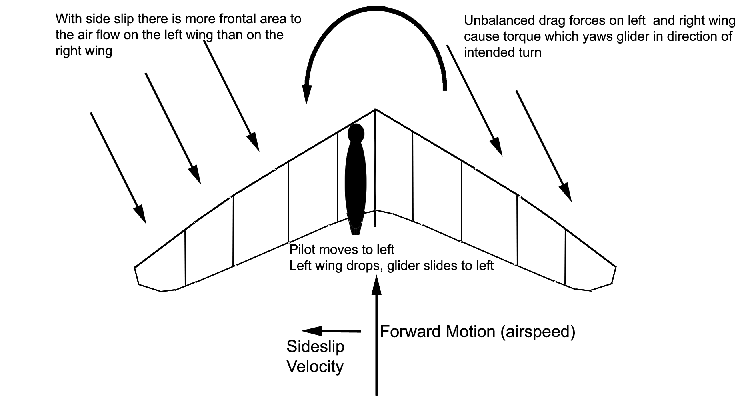
So far we have talked about yaw stability in straight-ahead flight, but
how about that left turn? As we roll left the glider will start 'slipping'
to the left as well. This is because the "lift" generated by an airfoil
acts perpendicular to the wing - not necessarily "up". Thus the lift
force is now acting up and to the left, while weight is still acting straight
down. These unbalanced forces will cause the glider to move sideways (slip)
to the left as well as continuing forward. This puts the left wing more
directly into the airflow thus causing a yawing moment that slows the left wing and
rotates it back. That is how our swept wing yaw stability comes into play to
overcome the adverse yaw effect from our roll motion.
Roll Instability
An unpowered aircraft inherently has a higher degree of roll stability
than when flying with power. For this discussion we are talking about
being in a
constant turn, such as doing 360's. In our constant turn to the left
our
left/inside wing is moving through the air slower than the outside
wing, thus we
would expect it to have less lift. However, because we do not have any
power,
we must also be moving downward relative to the air we are in (even if
that air
is moving upwards, as in a thermal or ridge lift). Both wings will be
moving downward at the same speed in a stable turn. Because the left
wing is
moving forward slower, this downwards motion causes it to have a
higher angle
of attack than the right wing.
If we add these two things together we have the potential for very nice
roll stability: the left wing is moving slower (less V) but has a
larger
angle of attack ('a') which increases CL(a). Putting both of those into
the
equation we see that it would not be hard to achieve a situation where
these two
effects exactly balance the higher V but lower CL(a) of the right
wing.
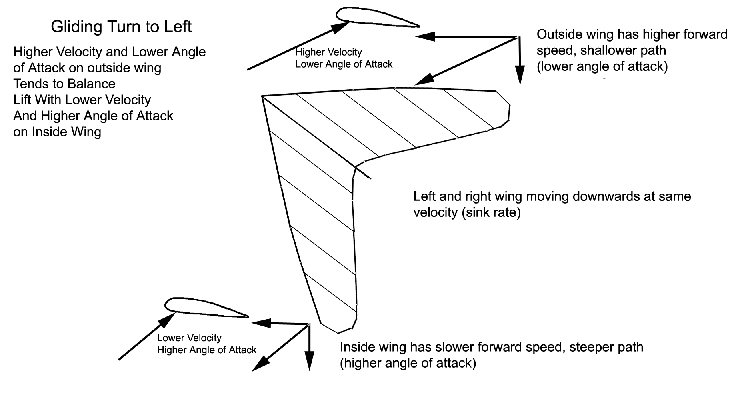
Now we add power. To begin with, let's add just enough power that we
are making our stable turn at constant altitude (air is not lifting or
sinking).
While the inside wing is still moving forward slower than the right
wing, neither
wing is moving downwards. Therefore the angle of attack is the same for
both.
The only thing in our lift equation that is different between the left
and right
wings is that V is smaller for the left wing. The right wing with the
larger V
will be generating more lift which creates a moment that wants to roll
the
glider ever more steeply.
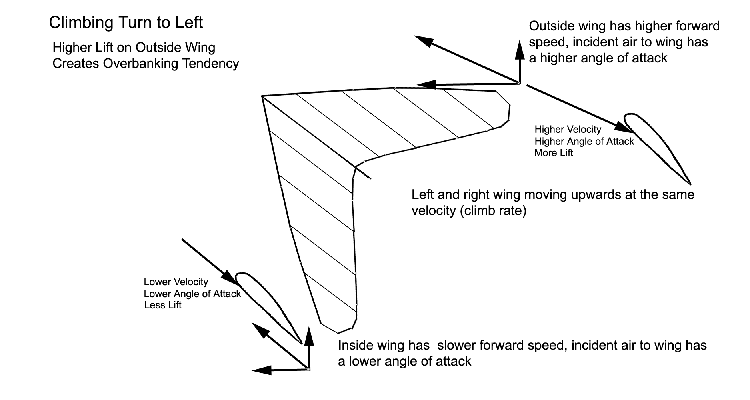
In climbing flight the upwards motion reverses the relative changes in
'a' for both wings. That is, 'a' increases for the right/outer wing -
so now
the right wing has both a higher V and higher CL(a) than the left wing,
and the
roll moment becomes even larger. Thus we can expect to do more "high
siding"
to maintain a stable turn under power than we do when gliding.
Thrust Line Direction
When we have power attached to our bodies we control the direction of
the thrust force by our body orientation, so orientation becomes much
more
important than when just gliding. Let's look at all three possible
orientations in
turn (and recall the convention that thrust is acting on the glider as
a
*forward* force).
Note
that these figures show only the effect of thrust line forces.
Many other forces also come into play, which are not shown here.
For a more indepth discussion, see the full write up:
FLPHGHandling.pdf (550 KB) Each
glider will have it's own way of combining these various effects - for
some the thrust line effects may hardly be noticeable, while for others
the thrust line force may dominate the handling.
Body Parallel to Keel
The thrust line remains parallel to the keel, however it is now offset
to the left. I have thought about this in a lot of different ways, but
the
simplest one is to simply think of a twin-engine aircraft with the
right engine
dead - the thrust acting to the left of the centerline will tend to yaw
the
glider to the right, just the opposite of what we want.
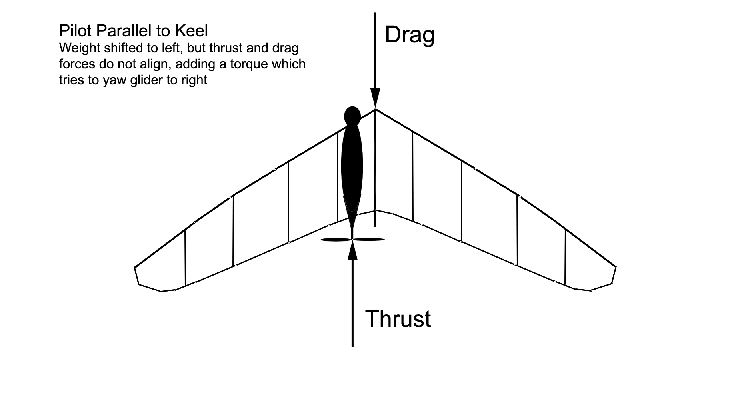 Feet First Roll
Feet First Roll
This is the standard method used by many hang glider pilots, myself
included (for unpowered flight) - the feet are moved farther in the
roll motion than the shoulders. One
good reason for doing this while free flying is that we are both moving
the
body sideways and rotating it about the hang point - the rotation
causes a
yawing torque on the glider which tends to turn it in the direction we
wish.
It is thought that this helps to produce "flatter" turns.
Now let's look at the thrust line direction. The pilots CG is displaced
to the left, but the feet/prop are further to the left, causing the
thrust
line to be twisted clockwise to the glider (when viewed from above).
This clockwise rotation of the thrust line causes a component of force
acting to push
the glider to the right. However, in order for the yaw stability of our
swept wing to come into action we need to be slipping to the left. Thus
under
power our feet-first roll technique becomes counter-productive.
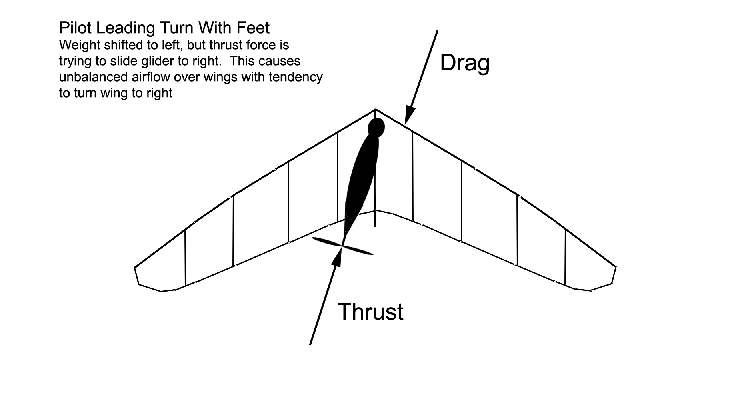 Head First Roll
Head First Roll
One of the first things new hang glider pilots learn is that if you
simply move the upper part of your body sideways you will have very
little control.
That is because instead of moving your CG to produce a roll input all
you have
really done is twisted your body about the hang point. After a few
panicked
episodes of "the glider wouldn't turn and I was as far over on the bar
as I could
go!" the new pilot learns about keeping their body parallel to the keel
(or even
leading with their feet). Experienced pilots simply don't consider
using a
head-first rolling motion.
Let's take another look at that, except with thrust added to the
picture. The pilot shifts his CG the same amount as with either the
parallel or
feet-first method, but rotated in the opposite direction from the
feet-first
method. That is, his head has moved the most to the left and his feet
the least. The
thrust line now has a sideways component to the left, which is
the direction
we want to turn and also the direction the glider needs to slip in
order for the
correct yaw to take place. It is my contention that this
head-first method is
the easiest way to initiate (or roll out of) a turn.
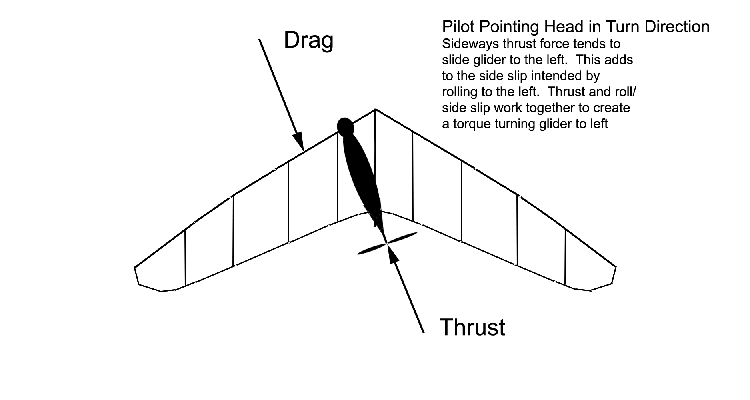 Experiments and Observations
Experiments and Observations
On a number of occasions I have proven to myself that I can
successfully turn the glider using only a yawed thrust line with no
roll input. The way I
have done this is to grasp the control bar with only 2 fingers on one
hand,
which I use to rotate myself about the hang point. Using those 2
fingers I am
not able to create any significant sideways movement of my CG, thus I
am not
creating a rolling moment. I have been able to do a series of reversing
turns
using this method. What I believe is happening is this: when I yaw the
thrust line
(let's saw CCW viewed from above) I am introducing a sideways force to
the
glider. This sideways force creates a side slip which then causes the
wing to
yaw to left because of the swept wing yaw stability. In this case the
mechanics work backwards because the yawing motion causes the left wing
to slow
(decreased lift) and right wing to speed up (increased lift) - thus
creating the
rolling moment to coincide with the yaw.
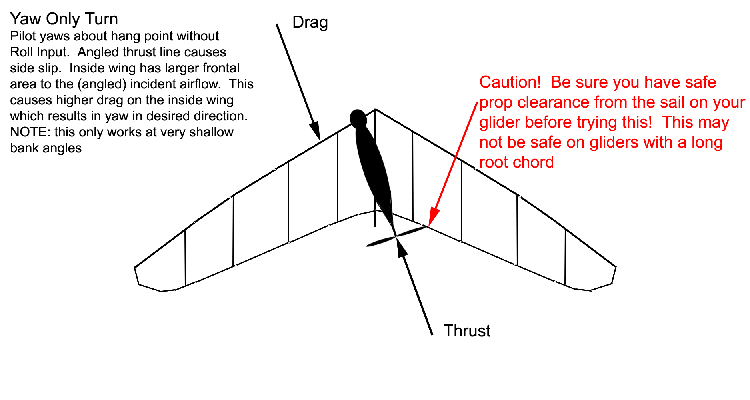
Here is a video clip that demonstrates a series of reversing turns
using nothing but the thrust line:
ThrustTurns.wmv
(UPDATE:
higher quality video on Vimeo)
In the video I do a series of 5 reversing turns (5 to left, 5 to right)
using thrust line only. Not that my right arm is dangling down
the entire time, and I am using only my left arm to rotate about the
hang point - and I can assure you, my wrists are not strong enough to
make any significant one-armed roll inputs.
Because of the relatively mild turns, the turn direction at times may
not be immediately obvious, but you can easily tell it from the position of the left
wing (the camera is mounted on the right wing tip). If the
visible wing tip is below the horizon, the glider is turning left, if
it is above the horizon, the glider is turning right.
Note that the turn reversal does not always happen immediately - it
sometimes takes as much as 10 or 15 seconds after I have rotated my
body before the glider follows. But I believe it is pretty clear
that whichever way my head is pointed is the direction the glider will
turn in.
There are definite limitations to the thrust-only turn method - I have
only been able to get it to work in smooth conditions and at shallow
bank angles.
It seems that at steeper bank angles the roll instability of flying
under
power is too great for this method to overcome. Once I am past more
than about 5
or 10 degrees I have to add some roll force to the yawed thrust line in
order
to reverse the turn.
There are also limitations on how far I can yaw my body before I am
blocked by the downtube. And if you are trying this with a glider that
is not high
aspect ratio (i.e., long root chord) - you will want to be very careful
that
you are keeping the prop clear of the sail!!! That does not appear to
be a
problem with my glider, but you should satisfy yourself that that is
the case with
your own glider before trying anything too radical!
Turning with only a yawed thrust line is a cute trick (and very handy
for staying on course when you have one hand busy, such as while
zipping up
your harness) but useful mainly for demonstrating the effect of the
thrust
line on turns. However, if we can turn only with a yawed thrust line,
then it
should be apparent that we can use the angle of the thrust line to
either help us
or hinder us when turning. If the glider will turn under nothing but a
roll input, and will also turn by simply yawing the thrust line, then
it should be
very easy when the two are combined. This has been my experience.
My hang glider will coordinate a 360 very nicely when flying without
power (that is, no roll force required to maintain a constant bank
angle), but tend
to spiral-in when flying with power. I have found that by simply yawing
my
body, so that the thrust line points slightly towards the upper wing, I
can
achieve a stable coordinated turn under full power without high siding.
And the
effort to roll out of the turn when directing the thrust towards the
high wing is
also greatly reduced.
Rigid Wings
Rigid wings have a different means of coupling roll and yaw. While a
flex wing glider is controlled by rolling the glider (which creates a
yawing
motion because of the swept wing design), a rigid wing works just the
opposite. A rigid wing is turned by inducing a yaw motion (creating
higher drag on
the inside wing via a control surface) which then creates the roll.
That is
because a rigid wing does not depend on having swept back wings to
maintain yaw stability. Instead it uses dihedral to maintain roll
stability
(dihedral is what you get when the wings form a V, instead of being
flat across the
top - instead of sweeping the leading edges backward at the tips as
with a flex wing, they are moved upward).
To demonstrate how this works, take an envelope or something similar
and fold it into a V. Hold it in front of you so that you are looking
directly down
the fold, and imagine that it is flying directly at you. Now turn it
about
the vertical axis in the CCW direction (as if it were yawed to it's
left)
and you will see that it's "right" wing (on your left) now has a much
greater
angle of attack, while it's left wing has had it's angle of attack
greatly
reduced - thus a moment has been created that tends the roll the glider
to it's left.
I have no personal experience with rigid wings, but I can offer two
observations that suggest how they will handle under power. The first
is that the
control surfaces out towards the tips of the wings are capable of
producing
large yawing moments by virtue of their long moment arms. This suggests
to me that
whatever effect a yawed thrust line has is very minor compared to the
control
afforded. The second is that the comments I have heard from rigid
wing flphg
pilots indicate that they seem to think handling is very easy, even
under full
power.
If you still have questions, I recommend the full article:
FLPHGHandling.pdf (550 KB)







